2020 Hyundai Tucson roof rack
[x] Cancel search: roof rackPage 89 of 637
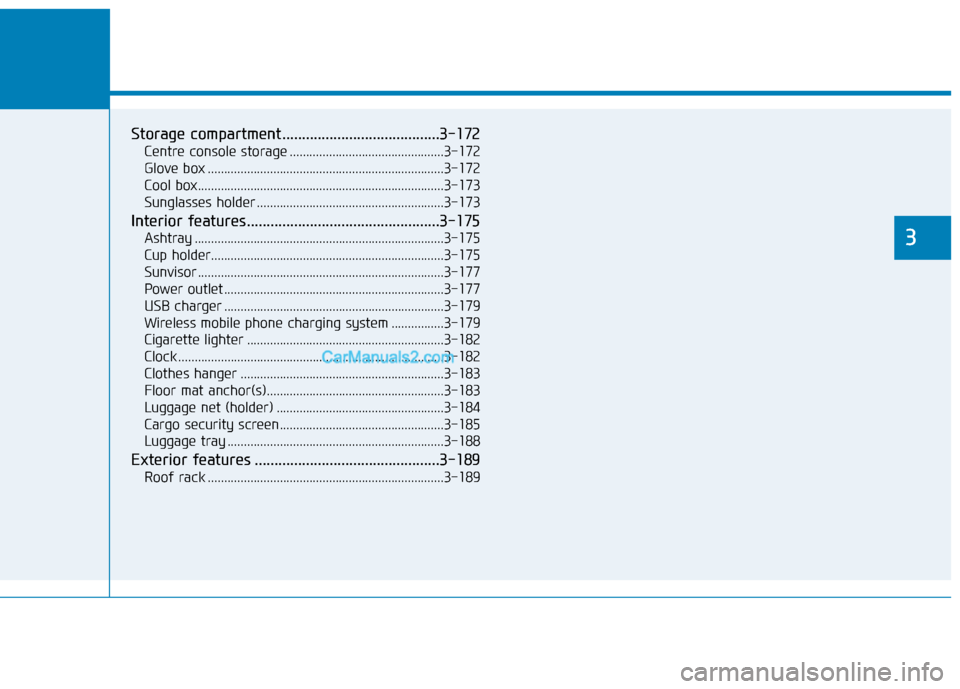
Convenient features of your vehicle
3
Storage compartment ........................................3-172
Centre console storage ...............................................3-172
Glove box ........................................................................3-172
Cool box...........................................................................3-173
Sunglasses holder .........................................................3-173
Interior features.................................................3-175
Ashtray ............................................................................3-175
Cup holder.......................................................................3-175
Sunvisor ...........................................................................3-177
Power outlet ...................................................................3-177
USB charger ...................................................................3-179
Wireless mobile phone charging system ................3-179
Cigarette lighter ............................................................3-182
Clock .................................................................................3-182
Clothes hanger ..............................................................3-183
Floor mat anchor(s)......................................................3-183
Luggage net (holder) ...................................................3-184
Cargo security screen..................................................3-185
Luggage tray ..................................................................3-188
Exterior features ...............................................3-189
Roof rack ........................................................................3-189
3
Page 275 of 637
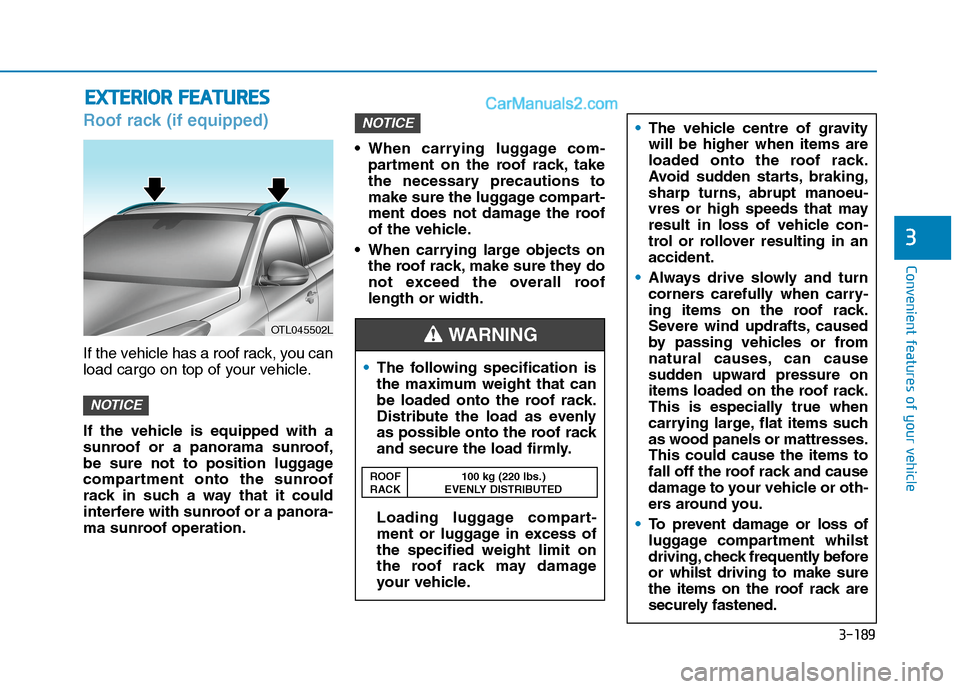
3-189
Convenient features of your vehicle
3
Roof rack (if equipped)
If the vehicle has a roof rack, you can
load cargo on top of your vehicle.
If the vehicle is equipped with a
sunroof or a panorama sunroof,
be sure not to position luggage
compartment onto the sunroof
rack in such a way that it could
interfere with sunroof or a panora-
ma sunroof operation. When carrying luggage com-
partment on the roof rack, take
the necessary precautions to
make sure the luggage compart-
ment does not damage the roof
of the vehicle.
When carrying large objects on
the roof rack, make sure they do
not exceed the overall roof
length or width.
NOTICE
NOTICE
E EX
XT
TE
ER
RI
IO
OR
R
F
FE
EA
AT
TU
UR
RE
ES
S
OTL045502L
The following specification is
the maximum weight that can
be loaded onto the roof rack.
Distribute the load as evenly
as possible onto the roof rack
and secure the load firmly.
Loading luggage compart-
ment or luggage in excess of
the specified weight limit on
the roof rack may damage
your vehicle.
WARNING
ROOF 100 kg (220 lbs.)
RACK EVENLY DISTRIBUTED
The vehicle centre of gravity
will be higher when items are
loaded onto the roof rack.
Avoid sudden starts, braking,
sharp turns, abrupt manoeu-
vres or high speeds that may
result in loss of vehicle con-
trol or rollover resulting in an
accident.
Always drive slowly and turn
corners carefully when carry-
ing items on the roof rack.
Severe wind updrafts, caused
by passing vehicles or from
natural causes, can cause
sudden upward pressure on
items loaded on the roof rack.
This is especially true when
carrying large, flat items such
as wood panels or mattresses.
This could cause the items to
fall off the roof rack and cause
damage to your vehicle or oth-
ers around you.
To prevent damage or loss of
luggage compartment whilst
driving, check frequently before
or whilst driving to make sure
the items on the roof rack are
securely fastened.
Page 278 of 637
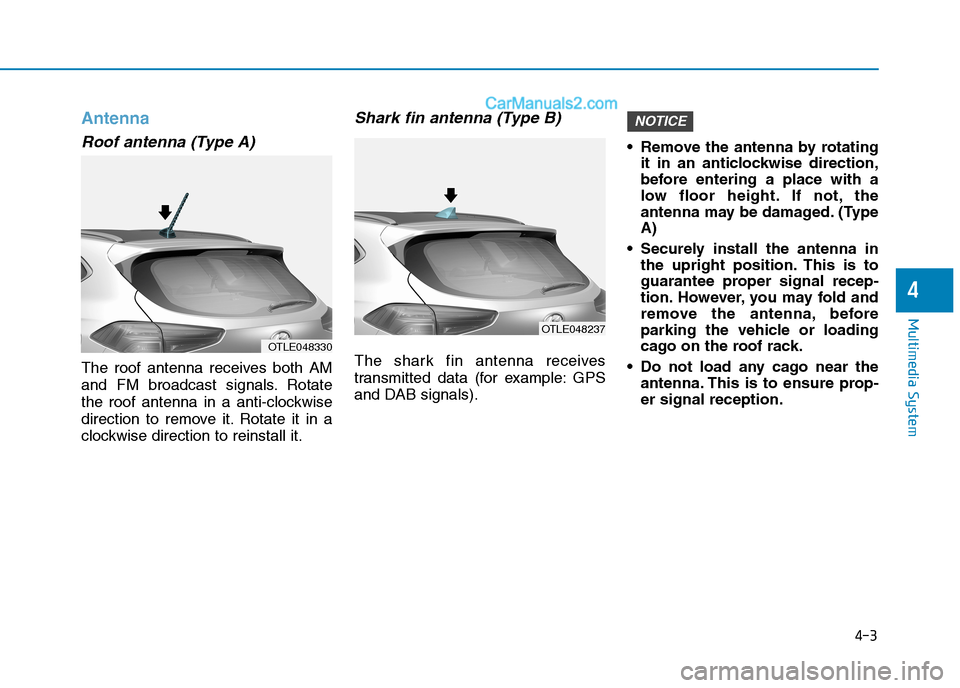
Antenna
Roof antenna (Type A)
The roof antenna receives both AM
and FM broadcast signals. Rotate
the roof antenna in a anti-clockwise
direction to remove it. Rotate it in a
clockwise direction to reinstall it.
Shark fin antenna (Type B)
The shark fin antenna receives
transmitted data (for example: GPS
and DAB signals). Remove the antenna by rotating
it in an anticlockwise direction,
before entering a place with a
low floor height. If not, the
antenna may be damaged. (Type
A)
Securely install the antenna in
the upright position. This is to
guarantee proper signal recep-
tion. However, you may fold and
remove the antenna, before
parking the vehicle or loading
cago on the roof rack.
Do not load any cago near the
antenna. This is to ensure prop-
er signal reception.
NOTICE
4-3
Multimedia System
4
OTLE048330
OTLE048237
Page 390 of 637
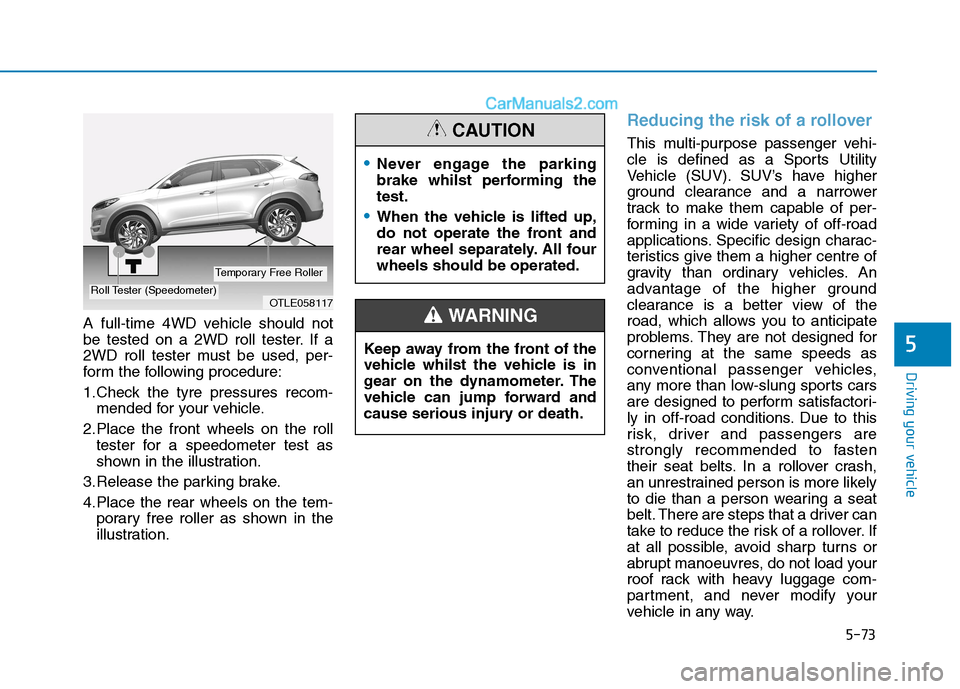
5-73
Driving your vehicle
5
A full-time 4WD vehicle should not
be tested on a 2WD roll tester. If a
2WD roll tester must be used, per-
form the following procedure:
1.Check the tyre pressures recom-
mended for your vehicle.
2.Place the front wheels on the roll
tester for a speedometer test as
shown in the illustration.
3.Release the parking brake.
4.Place the rear wheels on the tem-
porary free roller as shown in the
illustration.
Reducing the risk of a rollover
This multi-purpose passenger vehi-
cle is defined as a Sports Utility
Vehicle (SUV). SUV’s have higher
ground clearance and a narrower
track to make them capable of per-
forming in a wide variety of off-road
applications. Specific design charac-
teristics give them a higher centre of
gravity than ordinary vehicles. An
advantage of the higher ground
clearance is a better view of the
road, which allows you to anticipate
problems. They are not designed for
cornering at the same speeds as
conventional passenger vehicles,
any more than low-slung sports cars
are designed to perform satisfactori-
ly in off-road conditions. Due to this
risk, driver and passengers are
strongly recommended to fasten
their seat belts. In a rollover crash,
an unrestrained person is more likely
to die than a person wearing a seat
belt. There are steps that a driver can
take to reduce the risk of a rollover. If
at all possible, avoid sharp turns or
abrupt manoeuvres, do not load your
roof rack with heavy luggage com-
partment, and never modify your
vehicle in any way.
OTLE058117Roll Tester (Speedometer)
Temporary Free Roller
Never engage the parking
brake whilst performing the
test.
When the vehicle is lifted up,
do not operate the front and
rear wheel separately. All four
wheels should be operated.
CAUTION
Keep away from the front of the
vehicle whilst the vehicle is in
gear on the dynamometer. The
vehicle can jump forward and
cause serious injury or death.
WARNING
Page 472 of 637

5-155
Driving your vehicle
5
Reducing the risk of a rollover
Your multi-purpose passenger vehi-
cle is defined as a Sports Utility
Vehicle (SUV). SUV’s have higher
ground clearance and a narrower
track to make them capable of per-
forming in a wide variety of off-road
applications. The specific design
characteristics give them a higher
centre of gravity than ordinary vehi-
cles making them more likely to roll
over if you make abrupt turns. Utility
vehicles have a significantly higher
rollover rate than other types of vehi-
cles. Due to this risk, driver and pas-
sengers are strongly recommended
to buckle their seat belts. In a rollover
crash, an unrestrained person is sig-
nificantly more likely to die than a
person wearing a seat belt.
There are steps that a driver can
make to reduce the risk of a rollover.
If at all possible, avoid sharp turns or
abrupt manoeuvres, do not load your
vehicle with heavy cargo on the roof,
and never modify your vehicle in any
way.Utility vehicles have a signifi-
cantly higher rollover rate than
other types of vehicles. To pre-
vent rollovers or loss of control:
Take corners at slower speeds
than you would with a passen-
ger vehicle.
Avoid sharp turns and abrupt
manoeuvres.
Do not modify your vehicle in
any way that you would raise
the centre of gravity.
Keep tyres properly inflated.
Do not carry heavy luggage
compartment on the roof.WARNING
In a rollover crash, an unre-
strained person is significantly
more likely to die than a person
wearing a seat belt. Make sure
all passengers are wearing their
seat belts.
WARNING
Page 525 of 637
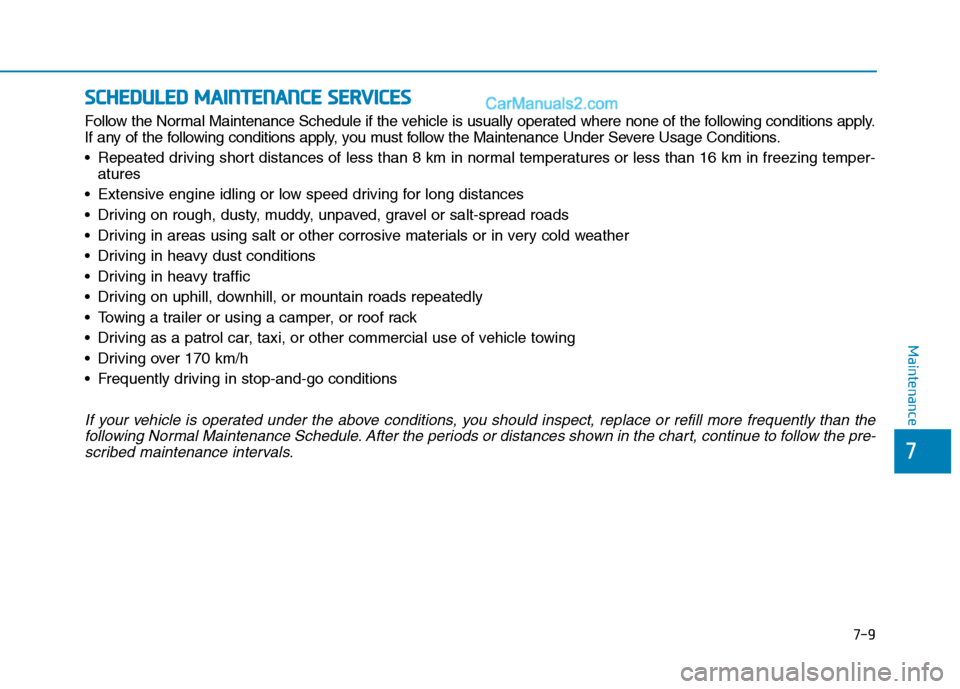
7-9
7
Maintenance
S SC
CH
HE
ED
DU
UL
LE
ED
D
M
MA
AI
IN
NT
TE
EN
NA
AN
NC
CE
E
S
SE
ER
RV
VI
IC
CE
ES
S
Follow the Normal Maintenance Schedule if the vehicle is usually operated where none of the following conditions apply.
If any of the following conditions apply, you must follow the Maintenance Under Severe Usage Conditions.
Repeated driving short distances of less than 8 km in normal temperatures or less than 16 km in freezing temper-
atures
Extensive engine idling or low speed driving for long distances
Driving on rough, dusty, muddy, unpaved, gravel or salt-spread roads
Driving in areas using salt or other corrosive materials or in very cold weather
Driving in heavy dust conditions
Driving in heavy traffic
Driving on uphill, downhill, or mountain roads repeatedly
Towing a trailer or using a camper, or roof rack
Driving as a patrol car, taxi, or other commercial use of vehicle towing
Driving over 170 km/h
Frequently driving in stop-and-go conditions
If your vehicle is operated under the above conditions, you should inspect, replace or refill more frequently than the
following Normal Maintenance Schedule. After the periods or distances shown in the chart, continue to follow the pre-
scribed maintenance intervals.
Page 531 of 637
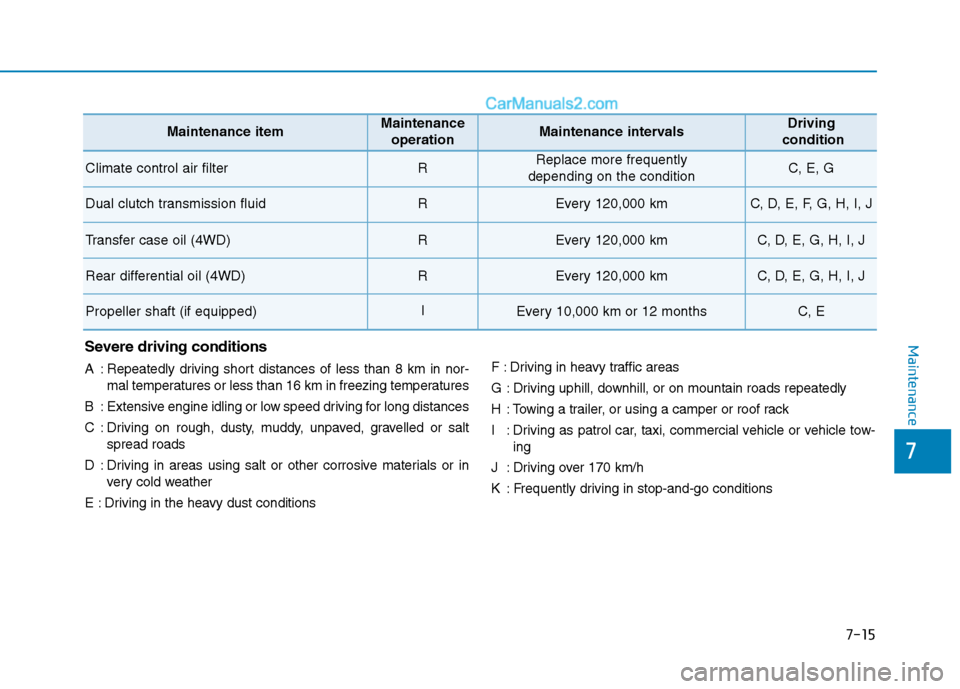
7-15
7
Maintenance
Maintenance itemMaintenance
operationMaintenance intervalsDriving
condition
Climate control air filterRReplace more frequently
depending on the conditionC, E, G
Dual clutch transmission fluidREvery 120,000 kmC, D, E, F, G, H, I, J
Transfer case oil (4WD)REvery 120,000 kmC, D, E, G, H, I, J
Rear differential oil (4WD)REvery 120,000 kmC, D, E, G, H, I, J
Propeller shaft (if equipped)IEvery 10,000 km or 12 monthsC, E
Severe driving conditions
A : Repeatedly driving short distances of less than 8 km in nor-
mal temperatures or less than 16 km in freezing temperatures
B : Extensive engine idling or low speed driving for long distances
C : Driving on rough, dusty, muddy, unpaved, gravelled or salt
spread roads
D : Driving in areas using salt or other corrosive materials or in
very cold weather
E : Driving in the heavy dust conditionsF : Driving in heavy traffic areas
G : Driving uphill, downhill, or on mountain roads repeatedly
H : Towing a trailer, or using a camper or roof rack
I : Driving as patrol car, taxi, commercial vehicle or vehicle tow-
ing
J : Driving over 170 km/h
K : Frequently driving in stop-and-go conditions
Page 537 of 637
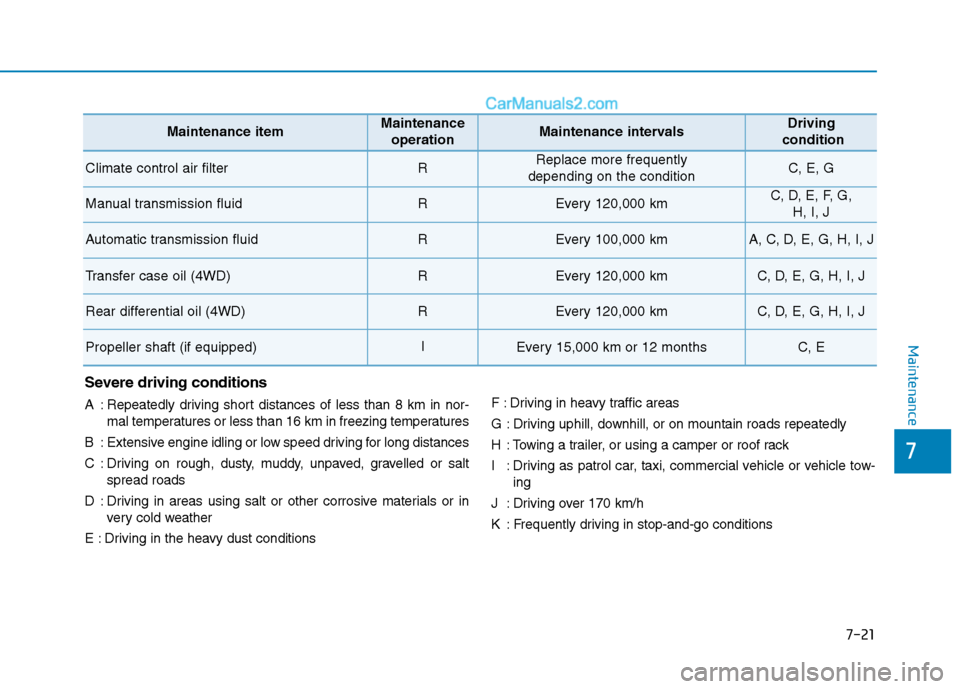
7-21
7
Maintenance
Maintenance itemMaintenance
operationMaintenance intervalsDriving
condition
Climate control air filterRReplace more frequently
depending on the conditionC, E, G
Manual transmission fluidREvery 120,000 kmC, D, E, F, G,
H, I, J
Automatic transmission fluidREvery 100,000 kmA, C, D, E, G, H, I, J
Transfer case oil (4WD)REvery 120,000 kmC, D, E, G, H, I, J
Rear differential oil (4WD)REvery 120,000 kmC, D, E, G, H, I, J
Propeller shaft (if equipped)IEvery 15,000 km or 12 monthsC, E
Severe driving conditions
A : Repeatedly driving short distances of less than 8 km in nor-
mal temperatures or less than 16 km in freezing temperatures
B : Extensive engine idling or low speed driving for long distances
C : Driving on rough, dusty, muddy, unpaved, gravelled or salt
spread roads
D : Driving in areas using salt or other corrosive materials or in
very cold weather
E : Driving in the heavy dust conditionsF : Driving in heavy traffic areas
G : Driving uphill, downhill, or on mountain roads repeatedly
H : Towing a trailer, or using a camper or roof rack
I : Driving as patrol car, taxi, commercial vehicle or vehicle tow-
ing
J : Driving over 170 km/h
K : Frequently driving in stop-and-go conditions